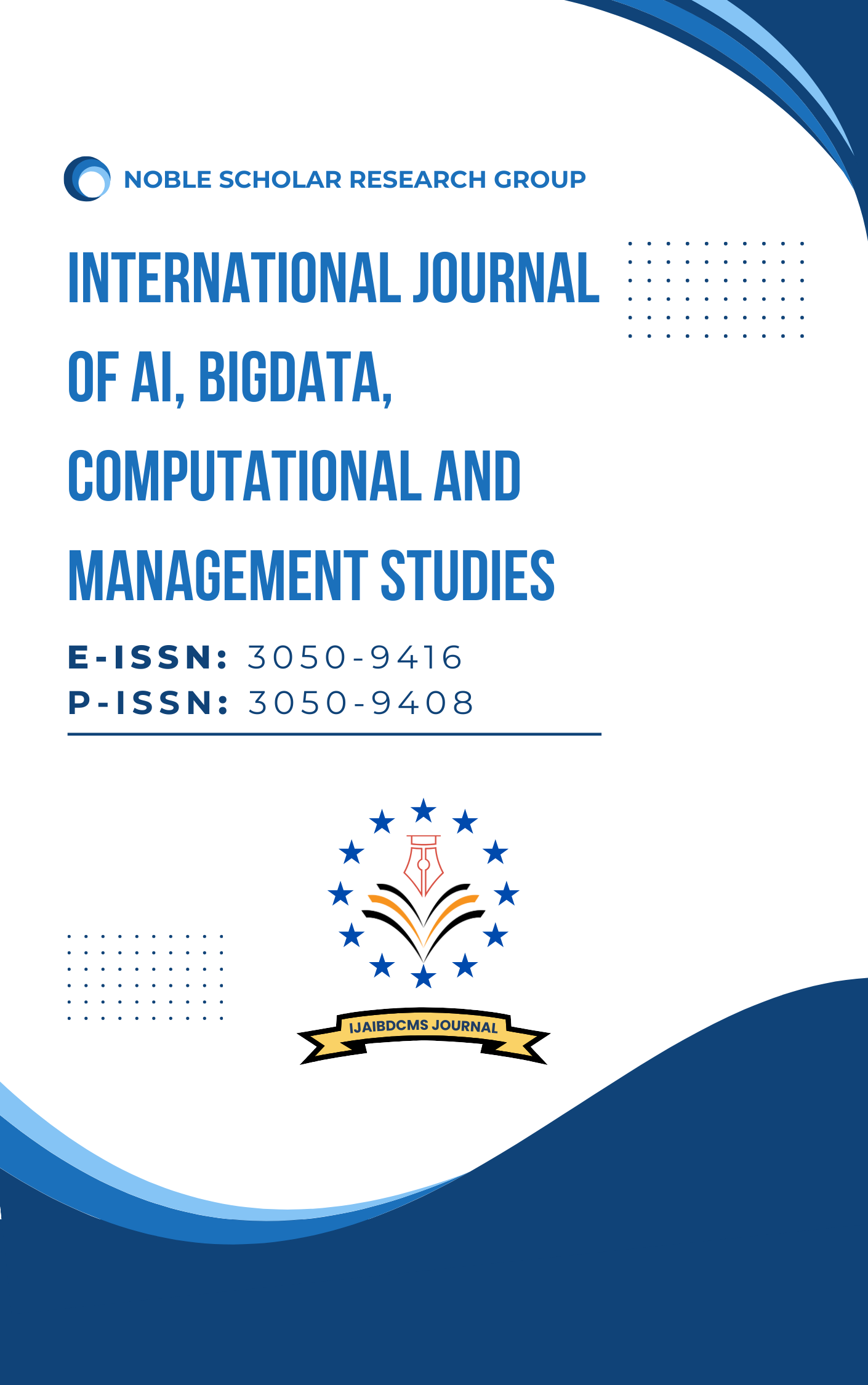Comprehensive Testing Procedures
DOI:
https://doi.org/10.63282/3050-9416.IJAIBDCMS-V2I1P104Keywords:
Graph Neural Networks (GNNs), Graph-Based Fraud Detection, Financial Fraud Prevention, Real-Time Transaction Monitoring, Anomaly Detection in Finance, Machine Learning for Fraud Detection, Deep Learning in Financial Services, Graph Analytics for Risk Assessment, AI-Powered Anti-Fraud Systems, Network-Based Anomaly Detection, Real-Time Graph Processing, Graph Embeddings for Fraud Detection, Credit Card Fraud Detection with GNNsAbstract
Fraud detection still presents a difficult problem in financial services, where fake transactions and identity theft result in significant economic losses. Conventional rule-based and machine learning techniques especially in real-time find it difficult to identify intricate, changing fraud activity. Since financial crime sometimes involves such links, strong fraud detection requires detailed modeling of the complex interactions between entities including users, transactions, and accounts. Since graph topologies allow links and relationships inside financial transactions to be represented, graph neural networks (GNNs) offer a robust technique of fraud detection. GNNs improve the identification of complex fraud schemes including synthetic identity fraud, money laundering, and transaction obfuscation by substituting connection patterns instead of traditional machine learning models that see transactions as discrete events. GNNs increase detection accuracy by including real-time processing capacity, thus supporting ongoing monitoring and adaptive fraud prevention and so reduce false positives. Real-time fraud detection utilizing GNNs lowers manual participation, improves fraud discovery rates, and improves adaptation to new fraud trends among other advantages. By seeing fraudulent behavior as it happens, financial firms using GNNs can reduce losses and get faster reaction times. Furthermore helping with decision-making and regulatory compliance is interpretability of graph-based models. This work explores real-time fraud detection with GNNs coupled with pertinent difficulties and innovations. A case study demonstrates how GNNs could be applied inside a financial company and their success in identifying dishonest behavior in transforming environments. Using anomaly detection inside network effects and graph structures enables the work to demonstrate how GNN-based solutions outperform conventional fraud detection methods. Important findings are the need for high-quality data, the effect of graph building methodologies, and the compromises between model complexity and real-time processing capability
References
1. Dray, S., Legendre, P., & Peres-Neto, P. R. (2006). Spatial modelling: a comprehensive
2. framework for principal coordinate analysis of neighbor matrices (PCNM). Ecological modelling, 196(3-4), 483-493.
3. Swofford, D. L., & Selander, R. B. (1981). BIOSYS-1: a FORTRAN program for the comprehensive analysis of electrophoretic data in population genetics and systematics. Journal of heredity, 72(4), 281-283.
4. Adams, P. D., Afonine, P. V., Bunkóczi, G., Chen, V. B., Davis, I. W., Echols, N., ... & Zwart, P. H. (2010). PHENIX: a comprehensive Python-based system for macromolecular structure solution. Biological crystallography, 66(2), 213-221.
5. Fulcher, G. (2014). Testing second language speaking. Routledge.
6. Kittler, R., Zhou, J., Hua, S., Ma, L., Liu, Y., Pendleton, E., ... & White, K. P. (2013). A comprehensive nuclear receptor network for breast cancer cells. Cell reports, 3(2), 538-551.
7. Binder, R. (2000). Testing object-oriented systems: models, patterns, and tools. Addison-Wesley Professional.
8. Rudestam, K. E., & Newton, R. R. (2014). Surviving your dissertation: A comprehensive guide to content and process. Sage publications.
9. Tyanova, S., Temu, T., Sinitcyn, P., Carlson, A., Hein, M. Y., Geiger, T., ... & Cox, J. (2016). The Perseus computational platform for comprehensive analysis of (prote) omics data. Nature methods, 13(9), 731-740.
10. Steel, R. G. D., & Torrie, J. H. (1960). Principles and procedures of statistics.
11. Diedenhofen, B., & Musch, J. (2015). cocor: A comprehensive solution for the statistical comparison of correlations. PloS one, 10(4), e0121945.
12. Sheskin, D. J. (2003). Handbook of parametric and nonparametric statistical procedures. Chapman and hall/CRC.
13. Xian, Y., Lampert, C. H., Schiele, B., & Akata, Z. (2018). Zero-shot learning a comprehensive evaluation of the good, the bad and the ugly. IEEE transactions on pattern analysis and machine intelligence, 41(9), 2251-2265.
14. Varma, Yasodhara. “Governance-Driven ML Infrastructure: Ensuring Compliance in AI Model Training”. International Journal of Emerging Research in Engineering and Technology, vol. 1, no. 1, Mar. 2020, pp. 20-30
15. Jeffrey, S. J., Carter, J. O., Moodie, K. B., & Beswick, A. R. (2001). Using spatial interpolation to construct a comprehensive archive of Australian climate data. Environmental Modelling & Software, 16(4), 309-330.
16. Varma, Yasodhara. “Secure Data Backup Strategies for Machine Learning: Compliance and Risk Mitigation Regulatory Requirements (GDPR, HIPAA, etc.)”. International Journal of Emerging Trends in Computer Science and Information Technology, vol. 1, no. 1, Mar. 2020, pp. 29-38
17. Kupunarapu, Sujith Kumar. "AI-Enabled Remote Monitoring and Telemedicine: Redefining Patient Engagement and Care Delivery." International Journal of Science And Engineering 2.4 (2016): 41-48.
18. Aday, L. A., & Cornelius, L. J. (2011). Designing and conducting health surveys: a comprehensive guide. John Wiley & Sons.
19. Albarracín, D., Gillette, J. C., Earl, A. N., Glasman, L. R., Durantini, M. R., & Ho, M. H. (2005). A test of major assumptions about behavior change: a comprehensive look at the effects of passive and active HIV-prevention interventions since the beginning of the epidemic. Psychological bulletin, 131(6), 856.



